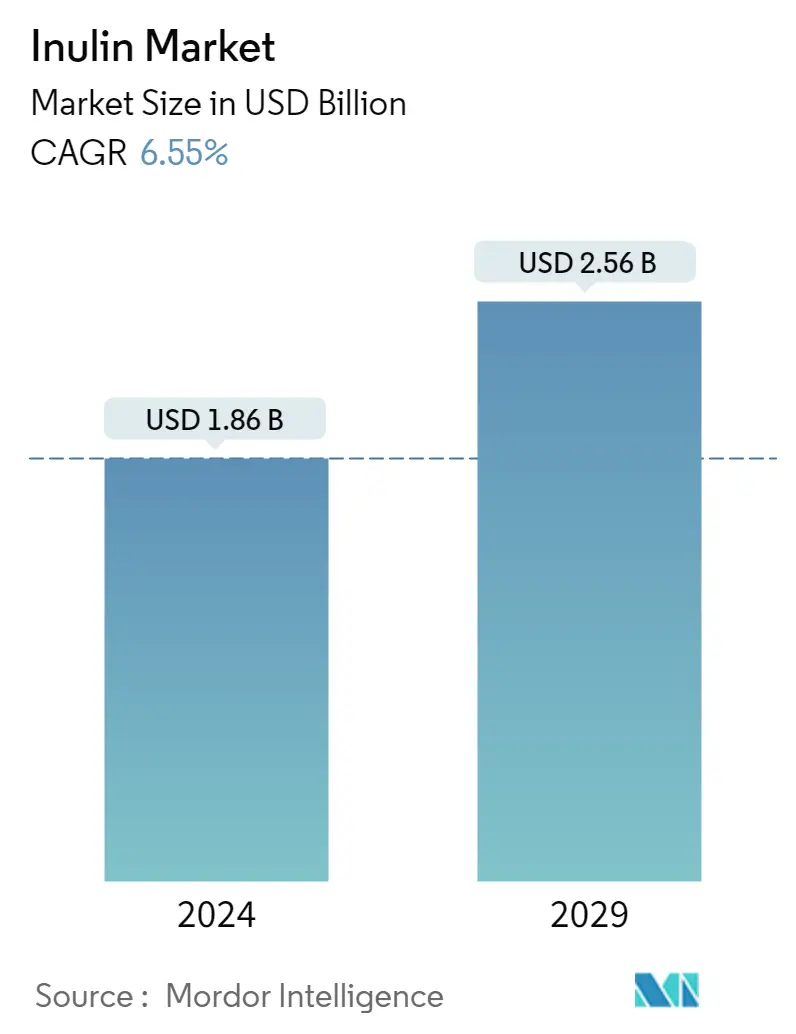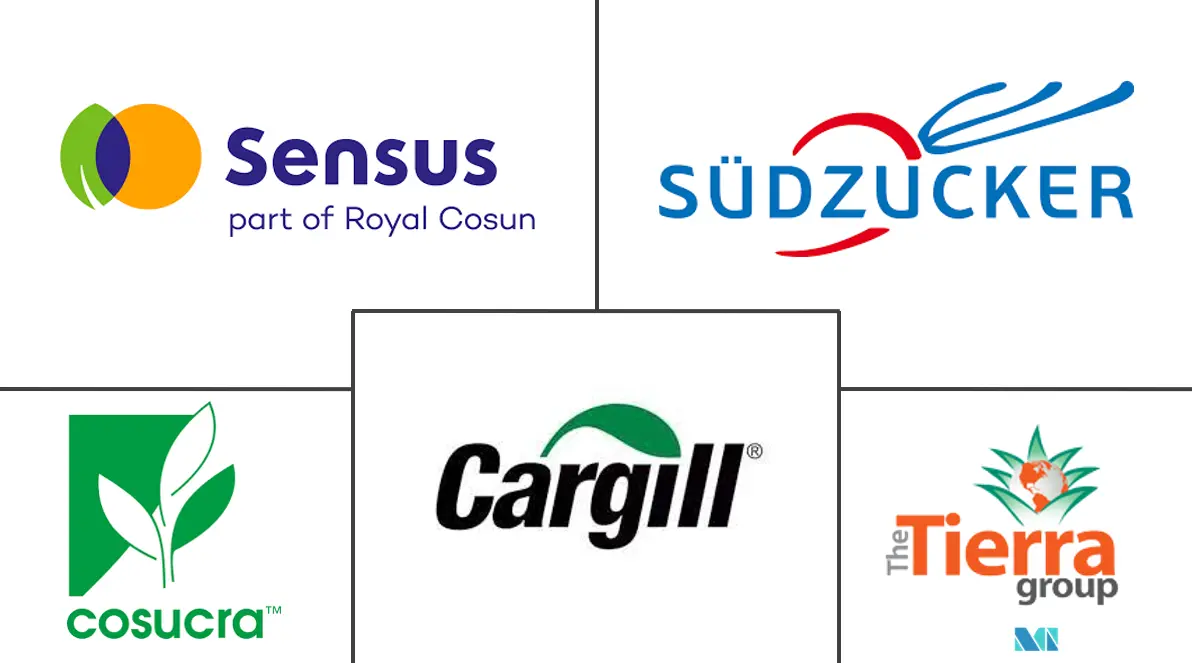Market Size of Inulin Industry

| Study Period | 2019 - 2029 |
| Market Size (2024) | USD 1.86 Billion |
| Market Size (2029) | USD 2.56 Billion |
| CAGR (2024 - 2029) | 6.55 % |
| Fastest Growing Market | Asia-Pacific |
| Largest Market | Europe |
| Market Concentration | Low |
Major Players
*Disclaimer: Major Players sorted in no particular order |
Inulin Market Analysis
The Inulin Market size is estimated at USD 1.86 billion in 2024, and is expected to reach USD 2.56 billion by 2029, growing at a CAGR of 6.55% during the forecast period (2024-2029).
- The global inulin market is poised to experience significant growth in the coming years, driven by the rising adoption of prebiotic ingredients in the dairy industry and the formulation of various dairy products. Furthermore, the increasing health awareness among consumers has led to a surge in demand for nutraceuticals, thereby boosting the demand for inulin. Inulin fiber has been found to aid in reducing obesity, diabetes, and cholesterol levels, leading to a growing demand for dietary fibers in nutraceutical products.
- The prevalence of digestive disorders such as pain, cramps, constipation, and bloating has been rising globally, leading to a surge in demand for fiber-rich and prebiotic-rich food and beverage products. The increasing geriatric population worldwide has also fueled the demand for healthy food. According to the United Nations Department of Economic & Social Affairs, the share of older persons in the global population is projected to increase from 9.3% in 2020 to 16.3% in 2050.
- Inulin has also gained popularity as a natural sugar replacer, with its presence enabling companies to label their products as having enhanced fiber content. Plant-based products have become a significant category for health-conscious consumers, driving the demand for chicory inulin. Key players in the global inulin market are focusing on launching innovative products and expanding production facilities to maintain their market dominance.
Inulin Industry Segmentation
Inulin is a naturally occurring, non-absorbable, and indigestible oligosaccharide found in the roots or tubers of various plants such as Jerusalem artichoke or chicory. It stimulates the growth of beneficial bacteria in the gut, including Lactobacilli and Bifidobacteria, thereby modulating the microflora composition.
The inulin market is segmented by application and geography. By application, the market is segmented into food and beverage, dietary supplements, and pharmaceuticals. Food and beverage are further segmented into bakery and confectionery, dairy products, meat products, beverages, and other foods and beverages. By geography, the market is segmented into North America, Europe, Asia-Pacific, South America, and Middle-East and Africa.
For each segment, the market sizing and forecasts have been done on the basis of value (in USD million).
| Application | |||||||
| |||||||
| Dietary Supplements | |||||||
| Pharmaceuticals |
| Geography | |||||||
| |||||||
| |||||||
| |||||||
| |||||||
|
Inulin Market Size Summary
The global inulin market is set to experience robust growth over the forecast period, driven by the increasing incorporation of prebiotic ingredients in the dairy sector and the rising consumer awareness regarding health benefits. Inulin, a type of dietary fiber, is gaining traction due to its potential in reducing obesity, diabetes, and cholesterol levels, which aligns with the growing demand for nutraceuticals. The surge in digestive disorders has further propelled the demand for fiber-rich and prebiotic-enriched food and beverages. Additionally, the aging global population is contributing to the heightened interest in healthy food options. Inulin's role as a natural sugar replacer and its popularity in plant-based products are also significant factors driving market expansion. Key industry players are focusing on innovation and production capacity expansion to maintain their competitive edge.
In Europe, the inulin market is primarily fueled by its application as a healthy substitute for fat and sugar in the food and beverage industry. Countries like the United Kingdom, France, Germany, and Spain are witnessing increased demand for inulin due to its functional benefits and its use in various food products. The competitive landscape is characterized by the presence of major players such as Cargill Inc., Südzucker AG, and Sensus NV, who are actively expanding their market presence and product offerings. These companies leverage their expertise and economies of scale to meet the rising demand for inulin globally. The market's growth is further supported by strategic investments and expansions in production facilities, ensuring a steady supply to meet consumer needs.
Inulin Market Size - Table of Contents
-
1. MARKET DYNAMICS
-
1.1 Market Drivers
-
1.2 Market Restraints
-
1.3 Industry Attractiveness - Porter's Five Forces Analysis
-
1.3.1 Bargaining Power of Suppliers
-
1.3.2 Bargaining Power of Consumers
-
1.3.3 Threat of New Entrants
-
1.3.4 Threat of Substitute Products
-
1.3.5 Degree of Competition
-
-
-
2. MARKET SEGMENTATION
-
2.1 Application
-
2.1.1 Food and Beverage
-
2.1.1.1 Bakery and Confectionery
-
2.1.1.2 Dairy Products
-
2.1.1.3 Meat Products
-
2.1.1.4 Beverage
-
2.1.1.5 Other Foods and Beverages
-
-
2.1.2 Dietary Supplements
-
2.1.3 Pharmaceuticals
-
-
2.2 Geography
-
2.2.1 North America
-
2.2.1.1 United States
-
2.2.1.2 Canada
-
2.2.1.3 Mexico
-
2.2.1.4 Rest of North America
-
-
2.2.2 Europe
-
2.2.2.1 United Kindgom
-
2.2.2.2 France
-
2.2.2.3 Germany
-
2.2.2.4 Spain
-
2.2.2.5 Rest of Europe
-
-
2.2.3 Asia-Pacific
-
2.2.3.1 China
-
2.2.3.2 Japan
-
2.2.3.3 Australia
-
2.2.3.4 India
-
2.2.3.5 Rest of Asia-Pacific
-
-
2.2.4 South America
-
2.2.4.1 Brazil
-
2.2.4.2 Argentina
-
2.2.4.3 Rest of South America
-
-
2.2.5 Middle-East and Africa
-
2.2.5.1 South Africa
-
2.2.5.2 Saudi Arabia
-
2.2.5.3 Rest of Middle-East and Africa
-
-
-
Inulin Market Size FAQs
How big is the Inulin Market?
The Inulin Market size is expected to reach USD 1.86 billion in 2024 and grow at a CAGR of 6.55% to reach USD 2.56 billion by 2029.
What is the current Inulin Market size?
In 2024, the Inulin Market size is expected to reach USD 1.86 billion.

